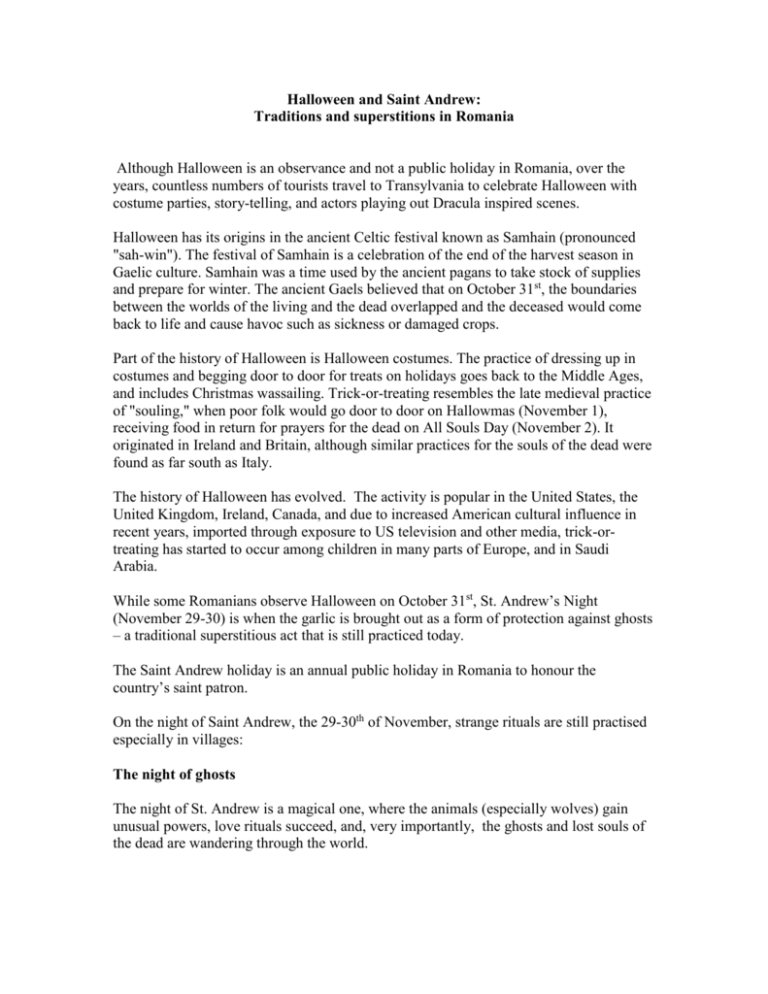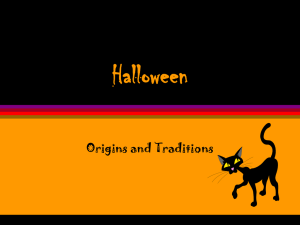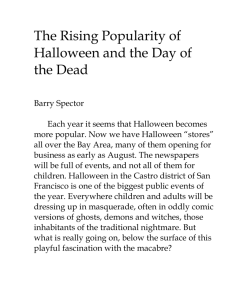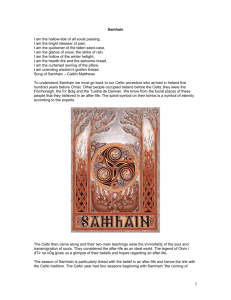Halloween and Saint Andrew holiday in Romania
advertisement

Halloween and Saint Andrew: Traditions and superstitions in Romania Although Halloween is an observance and not a public holiday in Romania, over the years, countless numbers of tourists travel to Transylvania to celebrate Halloween with costume parties, story-telling, and actors playing out Dracula inspired scenes. Halloween has its origins in the ancient Celtic festival known as Samhain (pronounced "sah-win"). The festival of Samhain is a celebration of the end of the harvest season in Gaelic culture. Samhain was a time used by the ancient pagans to take stock of supplies and prepare for winter. The ancient Gaels believed that on October 31st, the boundaries between the worlds of the living and the dead overlapped and the deceased would come back to life and cause havoc such as sickness or damaged crops. Part of the history of Halloween is Halloween costumes. The practice of dressing up in costumes and begging door to door for treats on holidays goes back to the Middle Ages, and includes Christmas wassailing. Trick-or-treating resembles the late medieval practice of "souling," when poor folk would go door to door on Hallowmas (November 1), receiving food in return for prayers for the dead on All Souls Day (November 2). It originated in Ireland and Britain, although similar practices for the souls of the dead were found as far south as Italy. The history of Halloween has evolved. The activity is popular in the United States, the United Kingdom, Ireland, Canada, and due to increased American cultural influence in recent years, imported through exposure to US television and other media, trick-ortreating has started to occur among children in many parts of Europe, and in Saudi Arabia. While some Romanians observe Halloween on October 31st, St. Andrew’s Night (November 29-30) is when the garlic is brought out as a form of protection against ghosts – a traditional superstitious act that is still practiced today. The Saint Andrew holiday is an annual public holiday in Romania to honour the country’s saint patron. On the night of Saint Andrew, the 29-30th of November, strange rituals are still practised especially in villages: The night of ghosts The night of St. Andrew is a magical one, where the animals (especially wolves) gain unusual powers, love rituals succeed, and, very importantly, the ghosts and lost souls of the dead are wandering through the world. The superstitions from elders claim that in order to be protected against wolves’ power and not attract them around the house, you shouldn’t brush your hair on that day, clean your house or take the trash out. On the night of November 29th it is believed that the houses are protected by ghosts if the pots are turned upside down and if the warm ash is taken from the stove, so the ghosts can’t shelter in there. That night, people also eat garlic and grease the doors and windows with garlic. The night of love rituals The girls believe that night they can see the man who they will marry, using different methods in each part of the country. 1) Method of the pot Alone in front of the stove the girl places three embers in a new pot of clay and rotates the pot saying a spell, attracting the attention of the beloved one. 2) Method of the ring In a glass with fresh water a ring is placed that has been blessed by a priest; the image of the future husband is shown. 3)Method of the mirror The girl sits between two mirrors with a burning candle in each hand and looks intensely in the front mirror. It is said that in the back mirror she will see scenes from the future and the image of her future husband. Each tradition and holiday has its charm, but the feast of St. Andrew is one of the most important as symbols for Romanians. If you have the opportunity to be in Romania of St. Andrew, do not miss the chance to witness the traditions and customs of the day.











